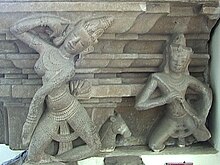Dhr. Seven, Amber Larson, Crystal Quintero, CC Liu, Wisdom Quarterly (Wikipedia edit)
 |
| SPACE.com: All about our solar system, outer space, and exploration. See Philae land. |
 |
| Sakka King of the Devas, Tanjung Pinang, Indonesia (Arthurcha/flickr.com) |
.
 |
| Apsara and gandharva in Cham, Vietnam |
They are classed among the Realm of the Four Great Sky Kings (Cāturmahārājikakāyika devas) subject to the Great King Dhṛtarāṣṭra, Guardian of the East.
 |
| Apsaras, celestial nymphs |
Beings are reborn among these celestial messengers as a karmic consequence of having practiced the most basic form of virtue and ethics (as illustrated in the Janavasabha Sutra, DN 18). It was considered embarrassing for a Buddhist monastic to be reborn in no better plane than that of a lowly deva (roughly a "messenger angel").
They can fly through the air, mainly in airships known as vimanas (mansions, platforms, immeasurable ships) and are known for their skill as musicians/entertainers. This may have given rise to the Christian belief in Lucifer as the Lord of Air and a lover of music even the Angel of Music.
 |
| The Buddha with Sakka and Brahma |
Earthly devas are connected with trees and flowers and are described as dwelling in the scents of bark, sap, and blossoms. They are among the beings of the wilderness that might disturb a Buddhist recluse meditating alone in the forest like his/her enlightened teacher. Gandharvas are just one rank higher, living longer lives in space worlds.
The terms gandharva and yakṣa (usually ogre or demon) are sometimes used for the same person; yakṣa in these cases is the more general term, including a variety of lower deities.
Among the notable gandharvas are mentioned (in DN 20 and DN 32) Panāda, Opamañña, Naḷa, Cittasena, and Rājā.
 |
| Sakka is "St. Michael" in Christianity. |
Janesabha is probably the same as Janavasabha, a rebirth of famous King Bimbisāra -- a royal follower of the Buddha, who ruled Magadha who the Buddha frequently resided. He was at least a stream enterer, someone who had reached the first stage of enlightenment.
Sakka/Śakra -- the king of the devas in two worlds, that of the Thirty-Three and Four Great Sky Kings -- has a charioteer (the driver of his spacecraft or vimana) is the gandharva Mātali, corresponding to Siddhartha's charioteer Channa.
Angels in Love
 |
| Angels (gandharvas) live in the higher reaches of the Sensual Sphere (Kama Loka) |
.
 |
| Semjase is likely a higher deva. |
Timbarū (Tumburu) was a chieftain of the gandharvas. There is a romantic story told about the love between his daughter, Bhaddā Suriyavacchasā (Sanskrit Bhadrā Sūryavarcasā) and another gandharva, Pañcasikha (Sanskrit Pañcaśikha).
Pañcasikha fell in love with Suriyavacchasā when he saw her dancing before Śakra, but she was in love with Sikhandī (Sikhaddi), the son of the charioteer Mātali. Pañcasikha then went to Timbarū's home and played a melody on his lute, which was made of fine beluva wood. He was very skillful on the lute and sang a love-song in which he interwove themes about the Buddha and his enlightened followers (arhats).
 |
| The devas at war with dragons, titans... |
Later, Śakra prevailed upon Pañcasikha to intercede with the Buddha so that Śakra might have an audience with him. As a reward for Pañcasikha's services, Śakra was able to get Suriyavacchasā, already pleased with Pañcasikha's display of skill and devotion, to agree to marry Pañcasikha. Sakra, by asking the Buddha a question, also reached stream entry.
Pañcasikha also acts as a messenger for the aforementioned Four Heavenly Kings, conveying news from them to Mātali, the latter representing Śakra and the World of the Thirty-Three (Trāyastriṃśa) devas.
Immortal Spirit?
 |
| Sylph-like Sakka and maids on Earth |
The term gandhabba is also used in a completely different sense, referring to a living being (strictly speaking a subtle manifestation of the causal continuum of consciousness) in a liminal state between death and birth -- which is easy to confuse with a "soul" or "spirit" as if that subtle body were the real "self" or immortal component within this denser mortal body. Both bodies are dependently arisen, impermanent, ultimately impersonal, and disappointing. Form (one of the Five Aggregates) refers to all materiality and is another component of what living beings confuse for a self, soul, ego, or permanent personality. Because common people consider gandharvas/gandhabbas to be "celestial musicians," confusion arose that angels attended on couples trying to conceive of children, as if they were storks. More sophisticated thinkers often make a similarly egregious error in thinking that a true "self" -- in the form of a spirit gandharva -- is transmigrating from body to body in the cycle of rebirth. Why this is a mistake is harder to comprehend without direct-insight (vipassana) into Dependent Origination or a solid grasp of the Buddhist doctrine of no-self anatta). More




















































































































































































































































No comments:
Post a Comment